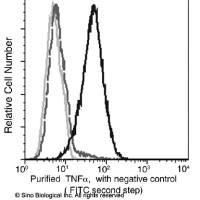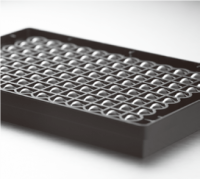Adaptation of Stem Cells to 96‐Well Plate Assays: Use of Human Embryonic and Mouse Neural Stem Cells in the MTT Assay
互联网
- Abstract
- Table of Contents
- Materials
- Figures
- Literature Cited
Abstract
Human embryonic stem cells (hESC) are difficult to adapt to 96?well plate assays, such as the MTT assay, because they survive best when plated as colonies, which are not easily counted and plated accurately. Two methods were developed to address this problem. In the first, ROCK inhibitor (ROCKi) was used, which allows accurate counting and plating of single hESC. In the second, small colonies were plated without ROCKi but with adaptations for accurate counting and plating. The MTT assay was also adapted for use with mouse neural stem cells. These methods allow the MTT assay to be conducted rapidly and accurately with high reproducibility between replicate experiments. When screening volatile chemicals in a 96?well plate, vapor effects may occur and dose ranges must be carefully defined. The methods were validated using the NIH assay guidance tool. These methodss could readily be translated to other 96?well plate assay. Curr. Protoc. Stem Cell Biol. 23:1C.13.1?1C.13.21. © 2012 by John Wiley & Sons, Inc.
Keywords: human embryonic stem cells; mouse neural stem cells; MTT assay; 96?well plate assays; toxicology
Table of Contents
- Introduction
- Basic Protocol 1: Preparing mNSC for the MTT Assay
- Support Protocol 1: Determining Cell Concentration with a Hemacytometer or a Spectrophotometer
- Support Protocol 2: Standard Curve Generation for Counting Cells with a Spectrophotometer
- Support Protocol 3: Plating mNSC for the MTT Assay
- Basic Protocol 2: MTT Assay
- Support Protocol 4: Assay Validation for the MTT Assay with mNSC: Plate Uniformity and Signal Variability
- Basic Protocol 3: Preparation of hESC for the MTT Assay Using the Single‐Cell Method with Rock Inhibitor
- Alternate Protocol 1: Preparation of Human Embryonic Stem Cells for the MTT Assay Using the Small‐Colony Method
- Support Protocol 5: Assay Validation for the Small‐Colony Procedure with hESC: Plate Uniformity and Signal Variability
- Reagents and Solutions
- Commentary
- Literature Cited
- Figures
- Tables
Materials
Basic Protocol 1: Preparing mNSC for the MTT Assay
Materials
Support Protocol 1: Determining Cell Concentration with a Hemacytometer or a Spectrophotometer
Materials
Support Protocol 2: Standard Curve Generation for Counting Cells with a Spectrophotometer
Materials
Support Protocol 3: Plating mNSC for the MTT Assay
Materials
Basic Protocol 2: MTT Assay
Materials
Support Protocol 4: Assay Validation for the MTT Assay with mNSC: Plate Uniformity and Signal Variability
Materials
Basic Protocol 3: Preparation of hESC for the MTT Assay Using the Single‐Cell Method with Rock Inhibitor
Materials
Alternate Protocol 1: Preparation of Human Embryonic Stem Cells for the MTT Assay Using the Small‐Colony Method
Materials
|
Figures
-
Figure 1.C1.1 Standard curve for determining mNSC concentration. This curve was produced by averaging three experiments performed on different days using different batches of cells. Eight cell counts were obtained for dilutions 1:2, 1:4, 1:8, and 1:16 using a hemacytometer. Percent transmittance readings were obtained for the undiluted sample, as well as dilutions 1:2 through 1:128. The micrograph (insert) shows mNSC in suspension. View Image -
Figure 1.C1.2 MTT plate design. Single, double, or triple replicates can be carried out. The top controls (CN) are used to generate the coefficient of variation for plating accuracy, and the bottom controls are used to assess the possibility of a vapor effect. The numbers 1 to 6 represent low to high doses plated. Letters A, B, etc. designate different test groups. In this design, six different chemicals can be tested in duplicate on one plate. View Image -
Figure 1.C1.3 Dose‐response curve showing the effect of phenol on mNSC. The x axis shows the doses tested, and the y axis shows the percent of the control ( n = 3). IC50 = inhibitory concentration at 50%, LOAEL = lowest observed adverse effect level, NOAEL = no observable adverse effect level. * = p < 0.05. View Image -
Figure 1.C1.4 The NIH Assay Guidance Wiki generates graphical data to check for edge effects and drift in the MTT plates. The validation experiment was carried out according to (Assay Validation: Plate Uniformity and Signal Variability), and no edge effects or drift were seen. (A ) Day 1 Plate 1. (B ) Day 1 Plate 2. (C ) Day 2 Plate 1. (D ) Day 2 Plate 2. These figures depict absorbance readings obtained for the three doses plotted as a function of column number. Different colors depict different doses: green, low dose/high signal; pink, mid dose/mid signal; blue, high dose/low signal. The readings from eight wells of one column of the plate are clustered together; for example, 1 to 8 on the x axis corresponds to eight wells in column 1. All the wells in each column had the same dose of chemicals. View Image -
Figure 1.C1.5 Phenol dose‐response curve using ROCKi to generate single cells. The x axis shows the doses tested, and the y axis shows the percent of the control ( n = 3). IC50 = inhibitory concentration at 50% and the NOAEL = no observable adverse effect level. ** = p ≤ 0.01. The LOAEL is between 3.19 × 10−5 and 9.37 × 10−5 M. View Image -
Figure 1.C1.6 Standard curve for hESC. This curve was generated by obtaining eight cell counts for dilutions of 1:2, 1:4, 1:8, and 1:16 using a hemacytometer and obtaining percent transmittance readings for an undiluted sample as well as dilutions 1:2 through 1:128. The micrograph (insert) shows hESC in a uniform small‐colony suspension. View Image -
Figure 1.C1.7 Phenol dose‐response curve using the small‐colony method. The x axis shows the doses tested, and the y axis shows the percent of the control ( n = 3). IC50 = inhibitory concentration at 50%, LOAEL = lowest observed adverse effect level, NOAEL = no observable adverse effect level. * = p < 0.05. View Image -
Figure 1.C1.8 The NIH Assay Guidance Wiki generates graphical data to check for edge effects and drift in the MTT plates. The validation experiment was carried out according to (Assay Validation: Plate Uniformity and Signal Variability), and no edge effects or drift were seen. (A ) Day 1 Plate 1. (B ) Day 1 Plate 2. (C ) Day 2 Plate 1. (D ) Day 2 Plate 2. These figures depict absorbance readings obtained for the three doses plotted as a function of column number. Different colors depict different doses: green, low dose/high signal; pink, mid dose/mid signal; blue, high dose/low signal. The readings from eight wells of one column of the plate are clustered together—for example, 1 to 8 on x axis corresponds to eight wells in column 1. All the wells in each column had the same dose of chemical. View Image -
Figure 1.C1.9 Variation in the MTT assay results when flicking versus swirling is used to keep cells in suspension. 5‐fluorouracil treatment of hESC is shown here where (A ) represents the flicking of cell suspension in a 15‐ml conical tube before plating each well with cells and (B ) represents swirling of the cell suspension in a 10‐ml glass beaker before plating each well with cells. The colored bars show quadruplicates for each dose. CN = control. View Image
Videos
Literature Cited
| Berridge, M.V., Tan, A.S., McCoy, K.D., and Wang, R. 1996. The biochemical and cellular basis of cell proliferation assays that use tetrazolium salts. Biochemica 4:14‐19. | |
| Blein, O., Ronot, X., and Adolphe, M. 1991. Cross contamination associated with the use of multiwell culture plates for cytotoxicity assessment of volatile chemicals. Cytotechnology 6:79‐82. | |
| Freshney, R.I. 2006. Basic principles of cell culture. In Culture of Cells for Tissue Engineering (R.I. Freshney and G. Vunjak‐Novakovic, eds.) pp. 3‐22. John Wiley & Sons, Hoboken, N.J. | |
| Fujimura, M., Usuki, F., Kawamura, M., and Izumo, S. 2011. Inhibition of the Rho/ROCK pathway prevents neuronal degeneration in vitro and in vivo following methylmercury exposure. Toxicol. Appl. Pharmacol. 250:1‐9. | |
| Grandjean, P., Bellinger, D., Bergman, A., Cordier, S., Davey‐Smith, G., Eskenazi, B., Gee, D., Gray, K., Hanson, M., van den Hazel, P., Heindel, J.J., Heinzow, B., Hertz‐Picciotto, I., Hu, H., Huang, T.T., Jensen, T.K., Landrigan, P.J., McMillen, I.C., Murata, K., Ritz, B., Schoeters, G., Skakkebaek, N.E., Skerfving, S., and Weihe, P. 2008. The faroes statement: Human health effects of developmental exposure to chemicals in our environment. Basic Clin. Pharmacol. Toxicol. 102:73‐75. | |
| Lin, S. and Talbot, P. 2011. Methods for culturing mouse and human embryonic stem cells. Methods Mol. Biol. 690:31‐56. | |
| Lin, S., Fonteno, S., Weng, J.H., and Talbot, P. 2010. Comparison of the toxicity of smoke from conventional and harm reduction cigarettes using human embryonic stem cells. Toxicol. Sci. 118:202‐212. | |
| Mossman, B.T. 1983. In vitro approaches for determining mechanisms of toxicity and carcinogenicity by asbestos in the gastrointestinal and respiratory tracts. Environ. Health Perspect. 53:155‐161. | |
| Ohgushi, M., Matsumura, M., Eiraku, M., Murakami, K., Aramaki, T., Nishiyama, A., Muguruma, K., Nakano, T., Suga, H., Ueno, M., Ishizaki, T., Suemori, H., Narumiya, S., Niwa, H., and Sasai, Y. 2010. Molecular pathway and cell state responsible for dissociation‐induced apoptosis in human pluripotent stem cells. Cell Stem Cell 7:225‐239. | |
| Parker, M.A., Anderson, J.K., Corliss, D.A., Abraria, V.E., Sidman, R.L., Park, K.I., Teng, Y.D., Cotanche, D.A., and Snyder, E.Y. 2005. Expression profile of an operationally‐defined neural stem cell clone. Exp. Neurol. 194:320‐332. | |
| Talbot, P. and Lin, S. 2011. Mouse and human embryonic stem cells: Can they improve human health by preventing disease? Curr. Top. Med. Chem. 11:1638‐1652. | |
| Watanabe, K., Ueno, M., Kamiya, D., Nishiyama, A., Matsumura, M., Wataya, T., Takahashi, J.B., Nishikawa, S., Muguruma, K., and Sasai, Y. 2007. A ROCK inhibitor permits survival of dissociated human embryonic stem cells. Nat. Biotechnol. 25:681‐686. | |
| Internet Resources | |
| http://assay.nih.gov/assay/index.php/Assay_Validation_2011 | |
| Assay validation Wiki. |









